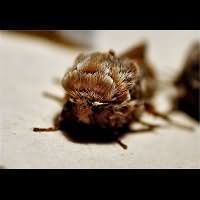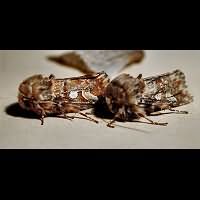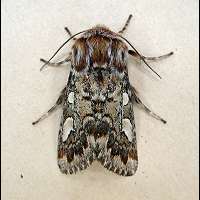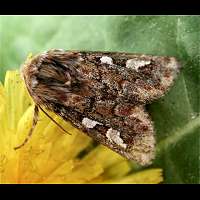Pine Beauty Panolis flammea
The Pine Beauty is a beauty indeed! The basic colour varies from greyish to reddish brown. Especially in fresh animals the scales glisten and many give the impression of being made of silver. Most striking though are the big kidney mark and impressive round mark. Both are white and extended on one side. The round spot is extended at the top side. The extension runs towards and often reaches the kidney spot. The kidney spot itself has an extension towards the tip of the wing on the lower side. The wingspan is 32 to 40mm. This species is unmistakable.
The eggs are being laid in rows on needles of the food plants. They hatch after about one week. The small caterpillars stay together and eat fresh shoots. When half grown they split up and start eating older needles. The caterpillars of Pine Beauties eat during the night only. At daytime they hide motionless between needles or twigs in the food plant and are extremely well camouflaged. By half July they'll start weaving a thin cocoon in crevices of the bark of the food plant, or among the fallen needles on the ground. In the cocoon they pupate. It is the pupa overwintering. Usually the caterpillar is green, but it might be brown. It has a few white lines running from head to tail. The lower line, running over the spiracula has the lower edge orange. The head is brown with lighter markings. The caterpillars reach a length of some 37 to 42mm. Like the animal's name indicates, the most important food plant is pine. Every now and then however caterpillars are found on fir, birch and oak.
The Pine Beauty is a single-brooded spring species, on the wing from late March to May. The moths only fly by night. During the day most rest head down on twigs of the food plant. The silvery scales, irregularly reflecting light, prove to be an excellent way of hiding oneself. For it is extremely difficult to detect a Pine Beauty at rest. Luckily they readily come to light and sugar. In such cases they often rest at a wall or a fence near the source of the light. When at rest it is easy to take pictures of the animals. They even allow you to handle them if you take care. The most important flowers for the adult animals are catkins. A very common species all over Britain, including the Inner Hebrides. An uncommon species in Ireland though. In northern parts of Europe, such as Scotland, Sweden and Norway this animal sometimes becomes a pest in pine forests.
The greyish form is referred to as Panolis flammea ab. grisea scientifically.
The Pine Beauty is a beauty indeed! The basic colour varies from greyish to reddish brown. Especially in fresh animals the scales glisten and many give the impression of being made of silver. Most striking though are the big kidney mark and impressive round mark. Both are white and extended on one side. The round spot is extended at the top side. The extension runs towards and often reaches the kidney spot. The kidney spot itself has an extension towards the tip of the wing on the lower side. The wingspan is 32 to 40mm. This species is unmistakable.
The eggs are being laid in rows on needles of the food plants. They hatch after about one week. The small caterpillars stay together and eat fresh shoots. When half grown they split up and start eating older needles. The caterpillars of Pine Beauties eat during the night only. At daytime they hide motionless between needles or twigs in the food plant and are extremely well camouflaged. By half July they'll start weaving a thin cocoon in crevices of the bark of the food plant, or among the fallen needles on the ground. In the cocoon they pupate. It is the pupa overwintering. Usually the caterpillar is green, but it might be brown. It has a few white lines running from head to tail. The lower line, running over the spiracula has the lower edge orange. The head is brown with lighter markings. The caterpillars reach a length of some 37 to 42mm. Like the animal's name indicates, the most important food plant is pine. Every now and then however caterpillars are found on fir, birch and oak.
The Pine Beauty is a single-brooded spring species, on the wing from late March to May. The moths only fly by night. During the day most rest head down on twigs of the food plant. The silvery scales, irregularly reflecting light, prove to be an excellent way of hiding oneself. For it is extremely difficult to detect a Pine Beauty at rest. Luckily they readily come to light and sugar. In such cases they often rest at a wall or a fence near the source of the light. When at rest it is easy to take pictures of the animals. They even allow you to handle them if you take care. The most important flowers for the adult animals are catkins. A very common species all over Britain, including the Inner Hebrides. An uncommon species in Ireland though. In northern parts of Europe, such as Scotland, Sweden and Norway this animal sometimes becomes a pest in pine forests.
The greyish form is referred to as Panolis flammea ab. grisea scientifically.









